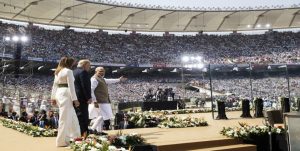On Monday, U.S. President Donald J. Trump began his state visit to India after arriving in the western city of Ahmedabad, in Indian Prime Minister Narendra Modi’s home state of Gujarat. Trump became the seventh U.S. president to visit India.
The two-day trip is still ongoing and will wrap up after the conclusion of several defense deals and other bilateral arrangements on Tuesday. Shortly after his arrival, however, Trump had an opportunity to set the tone for his time in India and the U.S.-India relationship for the rest of his time in office broadly by addressing an audience of some 110,000 in a cricket stadium in Ahmedabad.
Dubbed “Namaste Trump,” the event was India’s reciprocal arrangement for the September 2019 “Howdy Modi” event that an Indian-American organization had put together for an audience of 50,000 in the U.S. state of Texas. Trump attended that event and spoke well of Modi.
The official “Namaste Trump” event in India, meanwhile, allowed Trump to bask before one of the largest overseas audiences he’s drawn to date in office while giving a carefully prepared speech on the subject of U.S.-India relations and the U.S. approach to South Asia.
Despite visible tension in the U.S.-India relationship, particularly on matters of trade, Trump managed to deliver a speech on U.S.-India relations that sounded like something his predecessor — or his predecessor’s predecessor — might have said. In doing so, the speech succeeded in largely maintaining continuity in the relationship.
Of course, it was critical that Trump remain on message in Ahmedabad and not freelance by going off-script. The president, who is well-known for his gaffes and off-the-cuff remarks prone to generate controversy, spoke off a teleprompter for most of his speech.
Three core themes underpinned Trump’s address in India. The first was a broad recognition of India’s continued rise as a power and, with some exception, unalloyed praise for India’s rise as a democracy. Though not specified, the U.S. president’s language drew a contrast with Asia’s other major power — and recognized “great power” rival of the Trump administration — China.
“India’s rise as a prosperous nation is an example for every nation of the world and one of the outstanding achievements of the century,” Trump said in his speech. “It is all the more inspiring because you have done it as a democratic country, as a peaceful country, you have done it as a tolerant country, and you done it as a great, free country.”
Second, as anticipated, Trump steered clear of India’s ongoing internal political divisions over last year’s internal reorganization of the status of the erstwhile state of Jammu and Kashmir into a Union Territory with the same name, and a controversial citizenship bill that critics have said privileges non-Muslim migrants from India’s neighboring countries.
Still, despite steering clear of these issues, which are sensitive in New Delhi, Trump made repeated reference to India’s pluralistic polity and diversity in his remarks, highlighting, for instance, that India was “admired” because “millions upon millions of Hindus, and Muslims, Sikhs and Jains, Buddhists, Christians, and Jews worship side by side in harmony.”
The closest Trump came to addressing these matters directly was in his closing remarks, where he said the following: “today I say to every Indian, north and south, Hindu or Muslim, Jewish and Christian, young and old, take pride in the glories of your past, unite for an even brighter future, and let our two nations always stand together as powerful defenders of peace and liberty.”
Early reactions in India suggest these remarks didn’t transgress any of India’s own red lines, with Modi and the Indian government largely celebrating Trump’s speech.
A final takeaway that jumped out from Trump’s speech was the U.S. president’s decision to take on Pakistan and the U.S. relationship with Pakistan directly — all at a time when it is arguably a higher foreign policy priority for the Trump administration to cinch a peace agreement with the Afghan Taliban with Pakistan’s support.
In what was likely music to Indian ears, Trump underscored his administration’s efforts to work “in a very positive way with Pakistan to crack down on the terrorist organizations and militants that operate on the Pakistani border.” Trump added that the U.S. relationship with Pakistan was a “very good one” and the United States hoped to see “reduced tension, and greater stability and future harmony for all of the nations of South Asia.”
Those comments came almost one year after India and Pakistan faced off in a major skirmish along their disputed border in Kashmir after a Pakistan-based terrorist group claimed responsibility for one of the deadliest attacks on Indian paramilitary personnel in the region in decades.
Finally, Trump largely steered clear of difficulties between the United States and India, particularly on trade. While he acknowledged “differences” between the two countries, he touted what would be an “incredible” deal once finalized. Indian hopes to have a trade agreement cinched before the U.S. president’s arrival did not materialize.
Trump’s speech in India will likely be remembered for its remarkable positivity about India and the U.S.-India relationship. In the broader two-decades-long rapprochement between the two countries, the speech fits right in — even as broader disagreements persist between New Delhi and Washington.

































